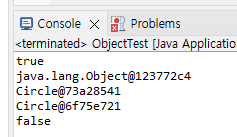※ 상속은 클래스 간에 계층 구조를 형성하여 속성과 메서드를 공유하고 재사용하는 개념
부모 클래스(상위 클래스)의 속성과 메서드를 자식 클래스(하위 클래스)가 물려받아 사용할 수 있도록 합니다.
class Vehicle {
// 부모 클래스의 속성과 메서드 정의
}
class Car extends Vehicle {
// 자식 클래스에서 추가적인 속성과 메서드 정의
}

ssn : 주민번호
자식 IS A 부모
(kind of)
자식은 부모의 한 종류이다라는 관계가 논리적으로 성립이 되어야함.
ex) 고객 is a 사람 ○ 사람이다/사람의 한 종류이다
사원 is a 사람 ○
계좌 is a 사람 X
계좌 HAS A 사람 관계가 성립되어야함
부모-자식 관계가 성립되면 부모 쪽 함부로 변경하면 안됨. 자식도 함께 변경되기 때문
자식 클래스는 부모 클래스의 모든 멤버에 접근이 가능하며, 자신만의 추가적인 멤버들을 정의할 수도 있다.
class Shape{ // 컴파일시 class Shape extends Object{} 로 바뀜.
// private double area;
protected double area;
double getArea() {
return area;
}
}
class Circle extends Shape { // shape로부터 확장된/상속받는 class이다. 자식 쪽에서 부모를 결정한다. 부모로부터 상속받으면 자식 class가 간결해짐. 재사용성이 높아짐.
private int radius;
Circle(int radius) {
this.radius = radius;
}
int getRadius() {
return radius;
}
void makeArea() {
area = 3.14 * radius * radius;
}
}
class Rectangle extends Shape {
private int width, length;
Rectangle(int width, int length) {
this.width = width;
this.length = length;
}
void makeArea() {
area = width * length;
}
}
public class ShapeTest { //=public class ShapeTest extends Object{}
//실행 시에 필요한 로드된 클래스 갯수 : public, object, string[], circle, system, rectangle 6개
public static void main(String[] args) {
Circle c = new Circle(5); // 반지름이 5인 원객체
System.out.println(c.getRadius()); //5
c.makeArea(); //원의 면적을 계산한다.
System.out.println(c.getArea()); //면적값 X.XXXX
Rectangle r = new Rectangle(3, 4); //가로3, 세로4인 사각형객체
r.makeArea(); // 사각형의 면적을 계산한다
System.out.println(r.getArea()); // 면적값 12.0
}
}



※ 자바최상위 클래스


java.lang.Object
hashCode(): int 객체를 식별해주는 객체정보값, 해시 코드 값이 같으면 같은 객체, 객체정보를 숫자로
equals(Object):boolean, 객체가 같은가 다른가
toString(): String, 객체정보를 문자로
// getClass().getName() + '@' + Integer.toHexString(hashCode()) @뒤를 16진수 값으로 리턴
public class ObjectTest {
public static void main(String[] args) {
Object o1;
Object o2;
Object o3;
o1 = new Object();
o2 = new Object();
o3 = o1;
System.out.println(o1.hashCode());
System.out.println(o2.hashCode());
System.out.println(o3.hashCode());
System.out.println(o1 == o2); //false
System.out.println(o1 == o3); //true
System.out.println(o1.equals(o2)); //false
System.out.println(o1.equals(o3)); //true
// true if this object is the same as the obj argument; false otherwise.
// this object는 o1이 참조하는 객체, obj argument가 o3
System.out.println(o1.toString()); //java.lang.Object@123772c4
Circle c1, c2;
c1 = new Circle(5);
c2 = new Circle(5); // 부모의 부모인 object로부터 상속 받을 수 있다. 상속의 깊이가 깊을 수록 변수가 재선언될 수 있다.
System.out.println(c1.toString()); //Circle@73a28541 (@ 뒤 16진수)
System.out.println(c2.toString()); //Circle@6f75e721
System.out.println(c1.equals(c2)); //false
}
}
'언어 > Java' 카테고리의 다른 글
| 오버라이딩(Overriding)과 다형성(Polymorphism) (0) | 2023.07.31 |
|---|---|
| 상속 예제 (0) | 2023.07.31 |
| 싱글톤 (0) | 2023.07.31 |
| 패키지 (0) | 2023.07.31 |
| Product 예제 1 (0) | 2023.07.31 |



